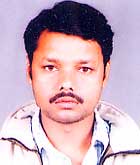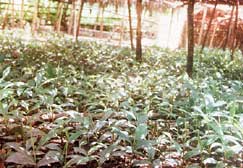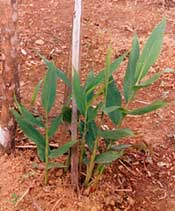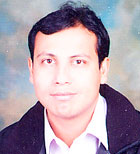|
|
 Fourth
CSE Media Fellowship Fourth
CSE Media Fellowship
Innovating Survival: Sustainable Development and Livelihoods in India’s North-east
 Anil Yadav Anil Yadav
Dainik Jagaran, Lucknow, Uttar Pradesh
Anil Yadav is an experienced journalist, currently working with
Dainik Jagaran, Lucknow. He has reported on important issues and events in the state from
the Ayodhya movement in the 1990s to the assembly elections and assembly proceedings. He
has also travelled the North East to study insurgency and socio-cultural changes in tribal
communities.
In his proposal for the fellowship, Anil wanted to study (a) The
‘Jugar’ boats on Brahmaputra in Guwahati as the source of livelihood for the
fishermen (b) Erosion of the Majuli Islands and steps taken to prevent it
(c) Open cast mining in Meghalaya and steps taken by government and
miners to modernise the age-old techniques (d) Bamboo-based water
harvesting systems in Manipur, and (e) Depletion of medicinal plants due
to uncontrolled trade and the trade route.
The jury felt that the proposal did mention relevant topics of concern, but was too
broad and lacked focus. The members suggested that Anil should be asked to select and
pinpoint a particular region within Arunachal Pradesh where trade in medicinal plants is
causing depletion of some particular species. They also suggested that the trade route of
a particular medicinal plant could then be traced down from Arunachal to Delhi or other
wholesale markets. Other points they thought important were the economics and business
trail of extraction, and the impact of extraction on biodiversity as well as the society
in the chosen region. He was asked to submit a re-worked proposal.
 |
| Black Cardamon at the
nursery of Regional Research Center (Ayurveda), I tanagar |
The re-worked proposal Anil sent focused on the illegal
and rampant trade in medicinal plants and herbs causing serious threat to bio-diversity
and tribal social fabric of north-east. Particularly in Arunachal Pradesh, regular
trade in herbs takes place in interior villages but the main centres are Bomdila,
Pasighat, East Kameng (Pakhul wild life sanctuary) and Namdapha reserve
forest in Changlong district. Shillong is one of the main centres in N-E. Other centres
are Tejpur, Guwahati, Dibrugarh, Goalpara, Silchar (Assam) and Aizwal (Mizoram).
Mukro in Jaintia hills, bordering Karbi Anglong district has been identified as a large
scale centre for trading in Usnea (Lichen) species.
His story ideas included the economics and business trail
of extraction, impact of extraction on bio-diversity, impact of trade on tribal society,
business chains: from villages to metros, and attitude of government and traditional
tribal councils.
Anil published five exhaustive stories in
Dainik Jagaran, Lucknow between December 23 and 28, 2004 and in Purvanchal Prahari between
December 10 and 14, 2004. His first story was on the illegal trade in medicinal plants and
herbs rampant in Arunachal Pradesh and the helplessness of the forest department in
stopping it. The story elaborates the route by which the medicinal plants are smuggled
across the state into Assam to the medicine markets of Kolkata and Delhi and finally to
the pharmaceutical companies. The story also highlights the complicity of officials from
the agriculture, forest departments and the police.
 |
| Ginger at the nursery of Regional
Research Centre (Ayurveda), Itanagar |
The second story highlighted the use of
the government machinery in smuggling of medicinal plants. Whatever government system has
been established to preserve biodiversity is now being used for smuggling. The story
informs how agents of pharmaceutical companies have established contractors in interior
villages of the state where they pay the tribals to get plants get the medicinal plants
for them.
The third story talks about the dangers
to the various medicinal plants due to this illegal trade. These herbs are gradually
disappearing as tribals sell them off to traders to earn a livelihood. The experts who are
aware of the dangers to these plants are unable to explain the crisis to tribals.
The fourth story focuses on the
government’s efforts raise awareness amongst the tribals to stop smuggling of
medicinal plants. The government in order to save their vote bank have started encouraging
tribals to farm medicinal plants and is providing support too. But the ground situation is
that the tribals are not availing the support due to the complex conditions. The officials
use fake names to complete their paperwork. The fifth story concentrates on the
difficulties faced by the tribals in farming and selling the medicinal plants, even though
the government has schemes and grants to encourage farming.
What Anil says about the fellowship
Earlier I knew very little about medicinal
plants and its trade. It gave me an opportunity to learn a lot of new things. Above all I
got a chance to interact with tribals of Arunachal Pradesh and came to know about
relationship between tribal life and jungle. It made the journey possible from “Books
to Jungle”.
North east
seldom gets space in media except insurgency and flood stories. It was a new experience
for readers to know about biodiversity of that region. They became aware about the illegal
trade in medicinal plants. The most common reaction was, it is same everywhere –
nexus of politicians, mafia and bureaucrats is ruining natural wealth.
Two exposes made by my stories were:
(a). Pharmaceutical agencies (companies) are employing trained Ayurvedic
doctors for collection of medicinal plants. They have become part of the smuggling nexus. (b).
Rare medicinal plants are being smuggled from Tibet to Dharamshala (Himachal Pradesh).
Route is via Nepal and Assam.
However the funds were insufficient for travelling and hence the fellowship amount should
increase. |
List of Stories
- Rampant illegal
trade of medicinal plants in Arunachal, Purvanchal Prahari, December 10, 2004
- Smugglers using
government resources, Purvanchal Prahari, December 11, 2004
- Endangered:
biodiversity and experts credibility, Purvanchal Prahari, December 12, 2004
- Medicinal plants
farmed on paper not on land, Purvanchal Prahari, December 13, 2004
- No assistance to
medicinal plants farmers, Purvanchal Prahari, December 14, 2005
^top
|
|
|
|
 Manish Tiwari Manish Tiwari
Principal Correspondent
The Hindustan Times, Chandigarh
Manish Tiwari has had an extensive carrier as a journalist. He has
worked with the Indian Express in Delhi, Down to Earth magazine and then shifted to The
Hindustan Times, Chandigarh, where he is writing on Punjab politics, economics,
environment and grassroots initiatives. He holds a professional degree in journalism from
the Indian Institute of Mass Communication, New Delhi.
In his project for the fellowship, Manish proposed to study the causes
of floods, and the extent of damage caused by the floods in the Brahmaputra river,
focusing on Assam. He also sought to look at the paradox of acute water scarcity in some
regions. He also proposed to examine the watershed management initiatives in Sikkim,
Arunachal and Meghalaya, their role in controlling floods and the extent of community
involvement in these initiatives. The jury approved Manish’s work plan without any
changes.
Manish did three stories, which were carried in The Hindustan Times
between December 25 and December 28, 2004. The first story was on the hydel power projects
proposed in the North East and their impact on the ecology and the local population at the
same time the claim of the government that dams would control floods.
The second story was a full page on the floods in Brahmaputra that
appeared in the Sunday magazine section of The Hindustan Times. The story focused on
impacts of floods in Assam, the impact, flood control measures and their failure in
providing protection to the affected communities. The story also focused on the causes of
the floods mainly the destruction of wetlands and watershed management as the possible
solution. The story brought out the extent of the flood problem. According to Manish,
large scale tree felling along with faulty government policies in solving the flood
problem was one of the reasons for the floods.
The third story was a short piece on drought in Cherapunji, which
receives an annual rainfall of 11,000 mm.
What Manish
says about the fellowship
During my years in Down to Earth, I reported many stories related to water and river
management so I was already familiar with the problem. However, this fellowship provided
me the opportunity to visit the Northeastern region for the first time, and therefore a
very valuable experience. I learned many new things. The issues relating to environment
and grassroots need to be focused in a big way, if we want to compel the governments to
take the issues seriously.
Some readers appreciated my stories but one generally sees that the state governments over
the years have grown less and less sensitive to reports, even those that are detailed and
in depth.
The story on Brahmaputra brought out the extent of the flood problem. Large scale tree
felling has lead to increase in the damages, exposing the government's faulty policies in
solving the flood problem. The story also brought out the miseries of the people in Assam
and other northeastern region.
Some suggestions: advertise your fellowships more widely so as to attract more
journalists. It might be useful to have fellowships of various levels, some suited to
journalists with just a couple years experience, others intended for senior staff. |
List of Stories
- Hydel projects set
to change the face of North East, The Hindustan Times, December 25, 2004
- Tackling
Brahmaputra, the river of sorrow, The Hindustan Times, December 26, 2004
- Wet drought in
Cherapunji, The Hindustan Times, December 28, 2004
^top
|
|
|
|
P Madhavan
Development Photojournalist
 P Madhavan, masters in Gandhian thoughts from Madurai Kamaraj
University, Tamil Nadu, is now a development photojournalist. He did a diploma in
photography from the Triveni Kala Sangam in New Delhi. He did a photo documentation of the
struggles of women mine workers and women affected by mining in their environments. The
photos were exhibited at the Third International Women and Mining Conference. He also did
another photo documentation project compiling the status report on hazardous waste
facilities in Delhi. The project was a part of submission made to the Supreme Court of
India. He also put up a photo exhibition on Uranium mining in Jaduguda, Jharkhand and
Domiasiat in Meghalaya. This exhibit was an event at the World Social Forum. P Madhavan, masters in Gandhian thoughts from Madurai Kamaraj
University, Tamil Nadu, is now a development photojournalist. He did a diploma in
photography from the Triveni Kala Sangam in New Delhi. He did a photo documentation of the
struggles of women mine workers and women affected by mining in their environments. The
photos were exhibited at the Third International Women and Mining Conference. He also did
another photo documentation project compiling the status report on hazardous waste
facilities in Delhi. The project was a part of submission made to the Supreme Court of
India. He also put up a photo exhibition on Uranium mining in Jaduguda, Jharkhand and
Domiasiat in Meghalaya. This exhibit was an event at the World Social Forum.
Madhavan had proposed to study coal mining West Khasi
Hills. He wanted to visually present the coal mines – abandoned, explored and
exploited – the people, and contaminated fields, rivers, resettled colonies and homes
around the mines. These families had turned to coal and limestone mining due to Supreme
Court’s ban on timber logging and trading activities. In West Khasi Hills region,
coal is mined by a primitive surface method called ‘rat hole’ mining. It is a
major source of air, water and soil pollution and also has tremendous health impact on the
mine workers.
The jury approved Madhavan’s original work plan and
expected him to generate entirely new images and new photo-features.
Madhavan published stories and photographs on the
charcoal makers of West Khasi Hills in The Statesman, New Delhi and Down to Earth, New
Delhi in December 2004. His story in The Statesman talked about the charcoal trade, which
emerged as the alternative livelihood since the Supreme Court banned logging. He reported
that the effect of charcoal extraction on forests was perhaps worse than that of timber
felling. Down to Earth published an interview done by Madhavan of a charcoal maker of
Umjarian village in the West Khasi Hills of Meghalaya. The same story was also published
by the Shillong based magazine, Eastern Panorama.
List of Stories
^top
|
|
|
|
 Sivasish Thakur Sivasish Thakur
Staff Reporter
The Assam Tribune, Guwahati, Assam
Sivasish Thakur has been writing on wildlife and biodiversity issues of the region.
He was awarded the R N Borooah Memorial Award for reporting on environmental issues for
the year 2003. He was previously with the other major English language newspaper of the
region, the Sentinel. Sivasish has been in the field of journalism since 1998 after having
studied English from Cotton College, Guwahati, Assam.
Sivasish’s work proposal sought to find out the reasons behind the transformation
of a valuable biodiversity rich area into a national park – the Manas – which
has been devastated by extremist action and the extent of damage it has caused. How the
possibility of conservation as a livelihood was extinguished by extremism? He also
proposed to look into the role of forest management policies and practices like JFM in the
existing situation. The level of understanding that people of the adjoining areas have
about the loss of flora and fauna and their involvement in conservation efforts.
 |
Encroachment
inside Manas National Park |
The Jury approved Sivasish’s work
plan with a few additions. Firstly the jury suggested him to also look at areas
surrounding Manas, where the situations were similar. The jury said that few grasslands
around Manas could be explored as the management practices there were bearing fruit. Also
captive breeding of small animals could be explored. Further the jury informed that
between Manas and Siliguri there was a forester’s kingdom, where there was a practice
called canopy-lifting operations (CLO). Under this old trees about to die or dying were
cut down to let others grow and the timber was used. But in the ‘80s, it was found
that in the interiors foresters, in the name of CLO, had clear-felled forests. The jury
suggested that this practice could be investigated.
Sivasish published three reports in Assam
Tribune between December 18, 2004 and December 25, 2004. The first report on the impact of
insurgency in Manas national park, informed that more than the insurgency the ensuing
negligence of the government and forest department destroyed the habitat and the
biodiversity of the region. That long after insurgency had finished, there were no visits
made by forest officers and patrolling by guards was rare. Due to this breakdown in the
security, poaching became rampant and continues to degrade the forests. As a result of all
these conditions, the forest cover has reduced drastically and the entire rhinoceros
population has been wiped out. In this report he also highlighted a case where the forest
officials working with the forest villagers and the All Bodo Students Union managed to
check poaching and the reducing forest cover.
 |
A timber smuggler or
poacher's camp inside the Manas National Park |
The second article was on the revival of
tourism in the park. The third article was on the question of restoring the national park.
The story highlighted the lack of a restoration plan for the sanctuary. The report said
that due to encroachments in the forest the habitat was under pressure, which was causing
deforestation and the rivers changing course. With the traditional rights of the forest
villages having been lost with the declaration of Manas as a protected area, the villagers
had also lost interest in conservation. The report however pointed out that the
administration was only starting to wake up and had taken a few steps towards stalling
further degradation.
According to Sivasish since there
hasn’t been such extensive reportage on after-effects of insurgency and social unrest
in Manas, both the state government and the Bodoland Autonomous Territorial District have
taken note of the reports and pledged their commitment to restore Manas.
What sivasish says about the fellowship
It has indeed been an extremely gratifying experience for me, and for
reasons more than one. Although I am interested in wildlife and environmental reporting
and has done some reports, this is the first time that I got the chance to devote myself
wholeheartedly to an important issue related to my interest on a longer term. Doing an
exhaustive and analytical report on the Manas National Park has always been in the back of
my mind, and the Fellowship provided me with the time and motivation to go ahead in my
pursuit.
Secondly, the Fellowship enabled me to gain a first-hand experience of the goings on in
Manas since it was affected by the prolonged social unrest. I was also able to spend a
number of days inside the Park, travel extensively in the forests, and see for myself the
ground situation. All this has been a valuable experience for me. And finally, I also feel
that I have been able to do at least some justice to my selection for the Fellowship, as I
managed to highlight the plight of a biodiversity hotspot and a World Heritage Site.
The
Fellowship allowed me to meet and interact with a number of people from different
backgrounds including forest staff and local inhabitants, most of whom proved to be of
immense help to me in doing the project. While it would be improper for me to pass any
judgment on my own reports, I really think that it has had some impact, especially on the
Forest Department and the environmental NGOs.
One major expose that I can claim to have made is the pictures I had taken of tree-felling
and poachers’ camps right in the middle of the Park, about which I had written
elaborately. Then, there is the case of the forest guards who prefer to move inside the
Park unarmed (This has been a policy of the Park authorities, as they fear that militants
may snatch away their arms). Fear of the forest staff for the local miscreants and
poachers has been another interesting revelation. I had reported how an angry mob
ransacked the Bhuyanpara Range office and assaulted some staff after some poachers’
camps and thelas used for smuggling timber had been destroyed. In a nutshell, exposing the
abysmal security scenario at Manas, which is a National Park, a World Heritage Site and a
Biosphere Reserve, has been the biggest accomplishment for me. |
List of Stories
^top |
|
|
|
|
|
|
 |
Souparno Banerjee /
Shachi Chaturvedi
Media Resource Centre
Centre for Science and Environment
41, Tughlakabad Institutional Area, New Delhi 110 062
Ph: 011-29955124, 29955125 Fax: 011-29955879
Emails: souparno@cseindia.org / shachi@cseindia.org |
|
|
|